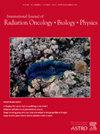Examining the Impact of Combined P53 Status and PD-L1 Expression on Vulvar Cancer Outcomes
IF 6.4
1区 医学
Q1 ONCOLOGY
International Journal of Radiation Oncology Biology Physics
Pub Date : 2024-10-01
DOI:10.1016/j.ijrobp.2024.07.043
引用次数: 0
Abstract
Purpose/Objective(s)
Vulvar cancer (VC) has a heterogeneous microenvironment with complex cellular and molecular interactions, which poses a challenge to predict clinical outcomes. VC is commonly known to associated with 2 pathways: HPV dependent, and independent pathway. Little is known about the combined impact of p53 and PD-L1 expression on VC prognosis. We aimed to examine the combined impact of p53 status and PD-L1 expression on treatment outcomes for vulvar cancer.
Materials/Methods
A single institutional retrospective study of 90 VC patients treated from 2010 to 2021 was conducted. P53 status was evaluated for wild-type (p53wt) versus aberrant (p53a) by immunohistochemical (IHC) expression. Positive PD-L1 status (PD-L1+) was defined as a Combined Positive score of ≥ 1. The VCs were classified into a 4-category scheme based on PD-L1 and p53 status (PD-L1/p53): PD-L1+/p53a; PD-L1+/p53wt; PD-L1-/p53a; and PD-L1-/p53wt. Associations with outcomes including overall survival (OS), disease-free survival (DFS), local control (LC), and regional control (RC) were assessed via log-rank tests and multivariable Cox regression analyses.
Results
The median age was 72 years (IOR = 62–80 years). Most cases (n = 88) were squamous cell carcinoma, 48% of FIGO I-II, 35% were positive for p16, and close to half (44%) were PD-L1+/p53a (see Table 1). Most (74%) received as initial treatment surgery± postoperative radio± chemotherapy (S+POT), versus 26% received upfront definitive chemoradiotherapy (DCRT). Median follow-up: 38 months (IQR = 17–66). The p53a VC showed a statistically significantly worse 5-yr OS (45%, 95 CI = 27–63) than the p53wt VCs (85%, 95 CI = 72–97, P = 0.01) as with DFS, LC, and RC. We observed a significant difference in 5yr OS when patients were stratified by initial treatments received (Table 1) and with 5-yr DFS, and RC as outcomes of measures. On multivariable analysis, PD-L1-/p53a status was associated with worse OS (HR = 3.6, 95% CI = 1.1–11.3) after controlling for p16 status, age, FIGO stage, and other clinicopathologic factors. Other PD-L1/p53 status groups were not found to be independent predictors of clinical outcomes.
Conclusion
These results suggest that PD-L1-/p53a VCs as a subtype are prognostic for worse OS. This classification suggests the complex interaction between p53 and PD-L1 and the potential prognostic significance for oncological outcomes. The PD-L1/p53 classification could help risk-stratify VCs in routine practice and potentially guide personalized therapy.
研究P53状态和PD-L1联合表达对外阴癌预后的影响
目的/目标:外阴癌(VC)具有异质性微环境,其细胞和分子相互作用十分复杂,这给预测临床结果带来了挑战。众所周知,外阴癌与两种途径有关:HPV依赖途径和独立途径。人们对 p53 和 PD-L1 表达对 VC 预后的综合影响知之甚少。我们旨在研究 p53 状态和 PD-L1 表达对外阴癌治疗结果的综合影响。通过免疫组化(IHC)表达评估野生型(p53wt)与异常型(p53a)的P53状态。PD-L1阳性状态(PD-L1+)定义为综合阳性得分≥1。根据 PD-L1 和 p53 状态(PD-L1/p53),将 VC 划分为 4 个类别:结果中位年龄为 72 岁(IOR = 62-80 岁)。大多数病例(n = 88)为鳞状细胞癌,48%为FIGO I-II,35%为p16阳性,近一半(44%)为PD-L1+/p53a(见表1)。大多数患者(74%)接受了手术+术后放疗+化疗(S+POT)的初始治疗,而26%的患者接受了前期明确化放疗(DCRT)。中位随访时间:38个月(IQR = 17-66)。在统计学上,p53a VC 的 5 年 OS(45%,95 CI = 27-63)明显低于 p53wt VC(85%,95 CI = 72-97,P = 0.01),DFS、LC 和 RC 也是如此。根据患者接受的初始治疗进行分层(表 1),并以 5 年 DFS 和 RC 作为衡量指标,我们观察到患者的 5 年 OS 存在显著差异。多变量分析显示,在控制了 p16 状态、年龄、FIGO 分期和其他临床病理因素后,PD-L1-/p53a 状态与较差的 OS 相关(HR = 3.6,95% CI = 1.1-11.3)。结论:这些结果表明,PD-L1-/p53a VC 作为一种亚型可预示较差的 OS。这一分类表明了 p53 和 PD-L1 之间复杂的相互作用以及对肿瘤预后的潜在意义。PD-L1/p53分类有助于在常规实践中对VC进行风险分级,并有可能为个性化治疗提供指导。
本文章由计算机程序翻译,如有差异,请以英文原文为准。
求助全文
约1分钟内获得全文
求助全文
来源期刊
CiteScore
11.00
自引率
7.10%
发文量
2538
审稿时长
6.6 weeks
期刊介绍:
International Journal of Radiation Oncology • Biology • Physics (IJROBP), known in the field as the Red Journal, publishes original laboratory and clinical investigations related to radiation oncology, radiation biology, medical physics, and both education and health policy as it relates to the field.
This journal has a particular interest in original contributions of the following types: prospective clinical trials, outcomes research, and large database interrogation. In addition, it seeks reports of high-impact innovations in single or combined modality treatment, tumor sensitization, normal tissue protection (including both precision avoidance and pharmacologic means), brachytherapy, particle irradiation, and cancer imaging. Technical advances related to dosimetry and conformal radiation treatment planning are of interest, as are basic science studies investigating tumor physiology and the molecular biology underlying cancer and normal tissue radiation response.

 求助内容:
求助内容: 应助结果提醒方式:
应助结果提醒方式:


